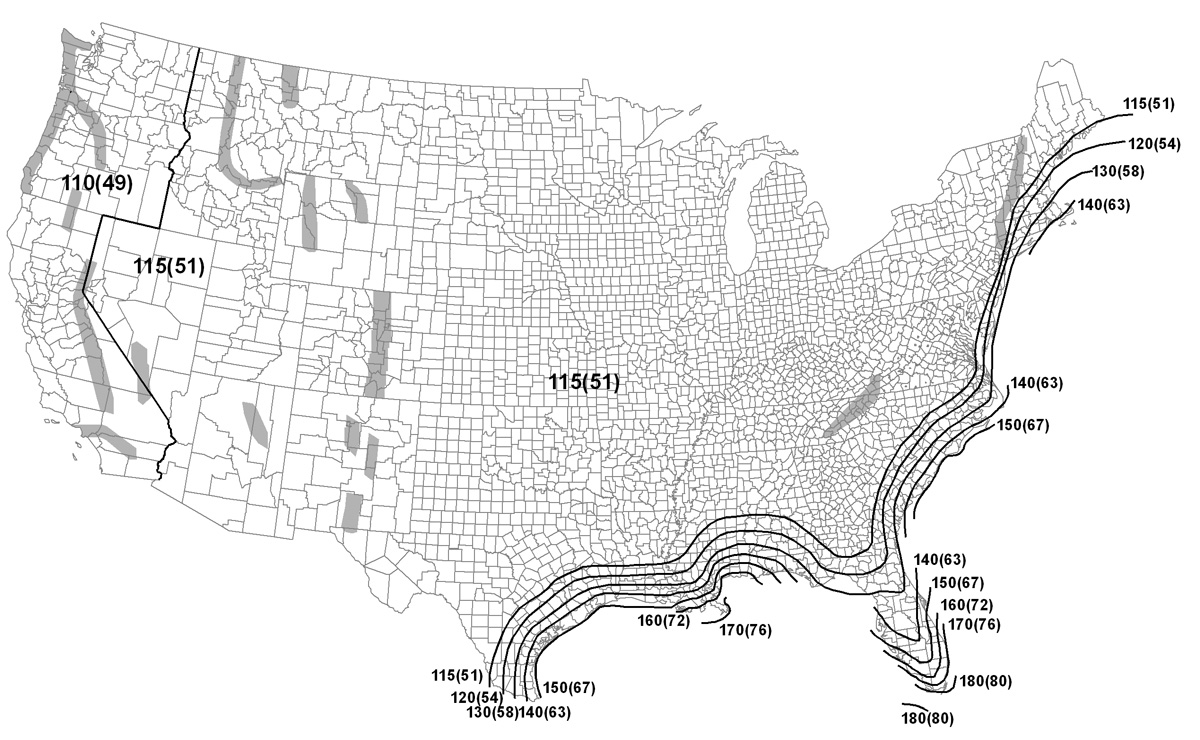ASCE 7 Hazard Tool will identify hurricane-prone regions and wind-borne debris regions, as defined in ASCE 7-16, Chapter 26 and ASCE 7-10. The ASCE 7 Hazard Tool is now available. Learn more about subscription options at asce7tools@asce.org.

ASCE 7-10 Wind Loads Ronald Cook1, Larry Griffis2, Peter Vickery3, Eric Stafford4 1 Civil and Coastal Engineering, University of Florida, Structures Division, Walter P. Moore and Associates, 3 Applied Research Associates, 4 T. Eric Stafford & Associates, 2 ABSTRACT ASCE 7-10 “Minimum Design Loads for Buildings and Other Structures” contains several changes regarding wind loads. The major editorial change is a complete reorganization to a multiple-chapter format as done previously for seismic loads with the objective being to make the provisions easier to follow. Technical changes include the introduction of new wind speed maps to be used with a 1.0 load factor for LRFD and a 0.6 load factor for ASD, the reintroduction of Exposure D for water surfaces in hurricane-prone regions, and revised wind-borne debris regions.
A new simplified procedure for buildings up to 160 ft has been added based on the provisions for buildings of all heights. INTRODUCTION The major changes to the wind load provisions of ASCE 7 introduced in ASCE 7-10 are: • • • • • Reorganization of wind load provisions Wind speed maps Re-introduction of Exposure D in hurricane-prone regions Wind-borne debris region Simplified procedure for buildings ≤ 160 ft This paper presents a general background on the basis for these changes. Thirty other changes related to wind loads were included in ASCE 7-10. The majority of these changes were editorial but some did include technical changes. These include: • • • • Minimum wind loads Improved exposure and roughness examples Revisions to low-rise “envelope” method Rooftop equipment REORGANIZATION OF WIND LOAD PROVISIONS The wind load provisions of Chapter 6 in ASCE 7 have been reorganized into 6 new Chapters. In recent years, there has been much discussion about the layout and presentation of the wind load provisions in ASCE 7.
While, ASCE 7-98 did make some improvements to the format (introduction of the 3 Methods), much of the important information was buried deep within the paragraph numbering. In addition, Method 2 Analytical Procedure actually contained several analytical methods embedded within the section (e.g., Buildings of All Heights and Low-rise Buildings). While the provisions were technically correct and properly numbered, understanding and applying the appropriate wind loads could be somewhat cumbersome. The primary goals of the reorganization effort were to keep the section numbering smaller and to locate major subject areas as distinct chapters. Additionally, it was desired to order the wind provisions in a logical sequence for the general structural design community. Accomplishing these goals led to the creation of 6 distinct chapters and the relocation of the provisions into their most logical new chapter. For example, the provisions for determining MWFRS loads are in separate chapters from Components and Cladding.
Top-notch customer support. Massive library of related video lessons and high quality multiple-choice questions. • Access in your classes, works on your mobile and tablet. • Easy to use, uniform format for every case brief. Filjm sumerki v perevode prituli. • The right amount of information, includes the facts, issues, rule of law, holding and reasoning, and any concurrences and dissents.
Additionally, the different methods for determining MWFRS loads are located in the 3 separate chapters – Chapter 27 Directional Procedure (formerly buildings of all heights in Method 2); Chapter 28 Envelope Procedure (formerly low-rise buildings in Method 2); and Chapter 29 Other Structures and Building Appurtenances (formerly embedded in Method 2). Each chapter was again subdivided into “parts” where deemed appropriate for clarity. For example in Chapter 28 the analytical method for determining wind loads for low-rise buildings is identified as Part 1 and the simplified method for determining wind loads for low-rise buildings is identified as Part 2. Similar subdivisions occur in Chapters 27 and 30.
To ease the transition to the new format and to facilitate improved awareness of the provisions applicable to the various methods, each chapter and parts contain tables that specifically identify and outline the steps and provisions applicable for that respective chapter or part. Table 27.2-1 shown below is an example of one of the outlines presented for Part 1 in Chapter 27.
Latest Pages
- Inpage Urdu Software Free Download 2013 For Windows 7
- Lectra Diamino Fashion V5r4 Crack
- Fon Dlya Prezentacii Priroda
- Object Oriented Software Engineering Ivar Jacobson Ebook Free Download
- Sonivox Vocalizer Vst Free Download
- Ea Koetting Works Of Darkness Pdf
- Heroes Of Might And Magic 4 Iso Free Download
- Instal Mikrotik Menggunakan Flashdisk
- Qcom Smart Tool Module